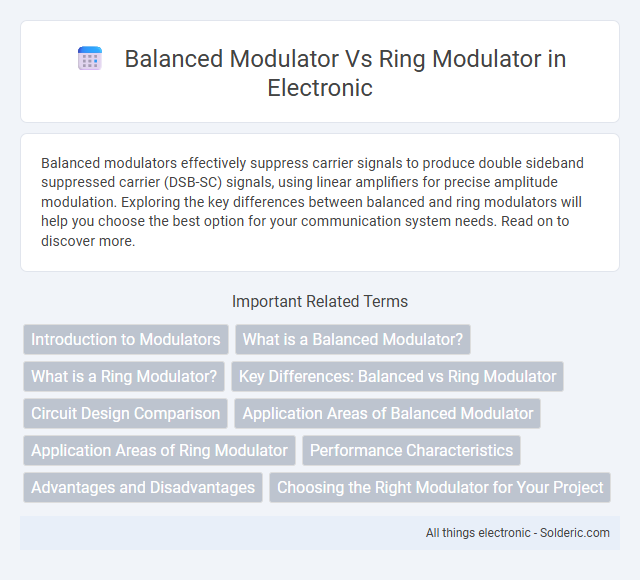Balanced modulators effectively suppress carrier signals to produce double sideband suppressed carrier (DSB-SC) signals, using linear amplifiers for precise amplitude modulation. Exploring the key differences between balanced and ring modulators will help you choose the best option for your communication system needs. Read on to discover more.
Comparison Table
| Feature | Balanced Modulator | Ring Modulator |
|---|---|---|
| Definition | Modulator that multiplies two signals while suppressing the carrier. | Type of balanced modulator using a ring of diodes for carrier suppression. |
| Carrier Suppression | Effective but may have residual carrier output. | Highly efficient carrier suppression with minimal leakage. |
| Implementation | Uses transformers or transistors in a balanced configuration. | Utilizes a diode ring circuit often with transformers. |
| Output Signal | Double sideband suppressed carrier (DSB-SC) signal. | DSB-SC with very low carrier component. |
| Linearity | Moderate linearity depending on components. | Generally higher linearity due to diode symmetry. |
| Complexity | Simpler design, easier to build. | More complex due to diode ring arrangement. |
| Typical Applications | Amplitude modulation, product detection. | SSB generation, frequency conversion in mixers. |
Introduction to Modulators
Balanced modulators and ring modulators are essential components in signal processing used to combine two input signals without passing the carrier frequency to the output. Balanced modulators typically use transistor or diode pairs to achieve amplitude modulation with reduced carrier leakage, while ring modulators employ a ring of diodes for improved suppression of the carrier and enhanced signal purity. Understanding these modulators helps you select the appropriate device for applications such as frequency translation, signal mixing, and communications.
What is a Balanced Modulator?
A balanced modulator is an electronic device designed to combine two input signals, typically a carrier and a modulating signal, to produce an output containing only the sum and difference frequencies, effectively suppressing the carrier frequency. Unlike ring modulators, balanced modulators use transistor or diode bridge circuits to achieve carrier suppression with reduced distortion and improved signal clarity. Understanding how a balanced modulator operates helps you optimize signal processing in applications such as double-sideband suppressed-carrier (DSB-SC) modulation and audio synthesis.
What is a Ring Modulator?
A ring modulator is an electronic device that multiplies two input signals to produce sum and difference frequencies, typically used in audio synthesis and telecommunications. It features a distinctive diode ring circuit that enables its unique nonlinear mixing properties, creating complex sideband sounds without the original input frequencies. Unlike balanced modulators, ring modulators provide high isolation between inputs and offer greater harmonic distortion control, making them popular for experimental sound design.
Key Differences: Balanced vs Ring Modulator
A balanced modulator suppresses the carrier signal by using two balanced mixers, producing a double-sideband suppressed carrier (DSB-SC) output with reduced distortion and improved signal clarity. A ring modulator employs a diode ring circuit to combine two signals, generating sum and difference frequencies with inherent nonlinearities that can introduce harmonic distortion useful in sound synthesis. Key differences lie in circuit topology and signal output: balanced modulators offer cleaner suppression and higher linearity, while ring modulators provide a more complex waveform and richer harmonic content.
Circuit Design Comparison
Balanced modulators employ a combination of diodes or transistors arranged in a bridge configuration to suppress the carrier signal, resulting in improved signal purity. Ring modulators utilize a diode ring circuit, typically four diodes in a loop, which offers simplicity and better isolation between input signals but may introduce more distortion. Your choice between these modulators depends on trade-offs in circuit complexity, signal distortion, and isolation requirements.
Application Areas of Balanced Modulator
Balanced modulators are primarily used in suppressed carrier amplitude modulation (AM) systems, making them essential in double-sideband suppressed carrier (DSB-SC) transmission for efficient bandwidth utilization. They find application in communication systems, such as single sideband (SSB) transmitters and mixers, where signal clarity and reduced interference are critical. Your choice of a balanced modulator can enhance signal processing performance in high-frequency communication and radar applications.
Application Areas of Ring Modulator
Ring modulators are widely used in audio signal processing, particularly for generating complex harmonic textures and metallic sounds in music production and sound design. They play a crucial role in telecommunications for frequency translation and signal mixing without adding extra carrier frequencies. Furthermore, ring modulators are integral to electronic test equipment and radar systems due to their ability to produce high-quality double sideband suppressed carrier signals.
Performance Characteristics
Balanced modulators offer high linearity with good suppression of carrier leakage, resulting in cleaner output signals ideal for amplitude modulation applications. Ring modulators, known for their superior carrier suppression and compact design, excel in generating double-sideband suppressed carrier (DSB-SC) signals with minimal distortion. Your choice between them depends on required signal purity and circuit complexity, with ring modulators favored for high-performance, low-distortion environments.
Advantages and Disadvantages
A balanced modulator offers better suppression of carrier signals, resulting in cleaner double-sideband suppressed carrier (DSB-SC) output, making it ideal for efficient amplitude modulation without carrier waste. However, it requires complex circuitry and precise component matching, increasing design complexity and cost. In contrast, a ring modulator provides a simpler, more compact design with high carrier suppression and low distortion, but suffers from diode nonlinearities and limited bandwidth, reducing overall signal fidelity in certain applications.
Choosing the Right Modulator for Your Project
Selecting the right modulator depends on your project's signal distortion tolerance and complexity requirements; balanced modulators provide low distortion amplitude modulation ideal for audio and communication applications. Ring modulators offer superior carrier suppression and produce sum and difference frequencies, making them perfect for innovative sound design and frequency mixing. Assess your need for signal purity versus creative sound effects to determine the optimal modulator type.
Balanced modulator vs ring modulator Infographic

 solderic.com
solderic.com